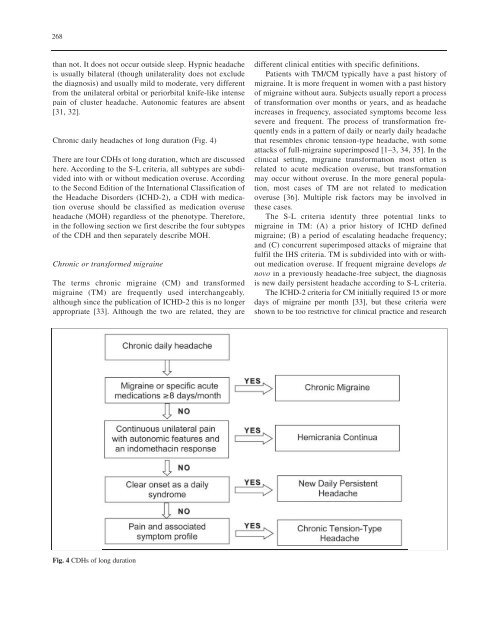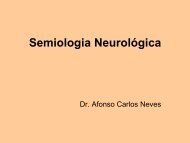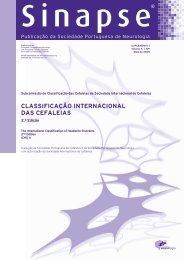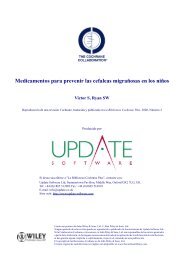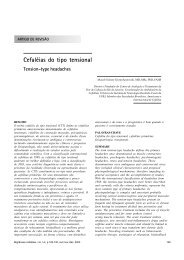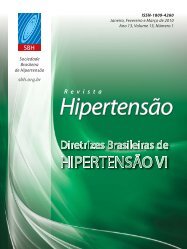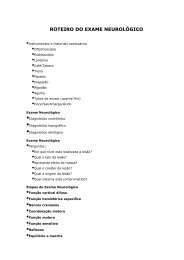The differential diagnosis of chronic daily headaches: an ... - marchioli
The differential diagnosis of chronic daily headaches: an ... - marchioli
The differential diagnosis of chronic daily headaches: an ... - marchioli
You also want an ePaper? Increase the reach of your titles
YUMPU automatically turns print PDFs into web optimized ePapers that Google loves.
268<br />
th<strong>an</strong> not. It does not occur outside sleep. Hypnic headache<br />
is usually bilateral (though unilaterality does not exclude<br />
the <strong>diagnosis</strong>) <strong>an</strong>d usually mild to moderate, very different<br />
from the unilateral orbital or periorbital knife-like intense<br />
pain <strong>of</strong> cluster headache. Autonomic features are absent<br />
[31, 32].<br />
Chronic <strong>daily</strong> <strong>headaches</strong> <strong>of</strong> long duration (Fig. 4)<br />
<strong>The</strong>re are four CDHs <strong>of</strong> long duration, which are discussed<br />
here. According to the S-L criteria, all subtypes are subdivided<br />
into with or without medication overuse. According<br />
to the Second Edition <strong>of</strong> the International Classification <strong>of</strong><br />
the Headache Disorders (ICHD-2), a CDH with medication<br />
overuse should be classified as medication overuse<br />
headache (MOH) regardless <strong>of</strong> the phenotype. <strong>The</strong>refore,<br />
in the following section we first describe the four subtypes<br />
<strong>of</strong> the CDH <strong>an</strong>d then separately describe MOH.<br />
Chronic or tr<strong>an</strong>sformed migraine<br />
<strong>The</strong> terms <strong>chronic</strong> migraine (CM) <strong>an</strong>d tr<strong>an</strong>sformed<br />
migraine (TM) are frequently used interch<strong>an</strong>geably,<br />
although since the publication <strong>of</strong> ICHD-2 this is no longer<br />
appropriate [33]. Although the two are related, they are<br />
different clinical entities with specific definitions.<br />
Patients with TM/CM typically have a past history <strong>of</strong><br />
migraine. It is more frequent in women with a past history<br />
<strong>of</strong> migraine without aura. Subjects usually report a process<br />
<strong>of</strong> tr<strong>an</strong>sformation over months or years, <strong>an</strong>d as headache<br />
increases in frequency, associated symptoms become less<br />
severe <strong>an</strong>d frequent. <strong>The</strong> process <strong>of</strong> tr<strong>an</strong>sformation frequently<br />
ends in a pattern <strong>of</strong> <strong>daily</strong> or nearly <strong>daily</strong> headache<br />
that resembles <strong>chronic</strong> tension-type headache, with some<br />
attacks <strong>of</strong> full-migraine superimposed [1–3, 34, 35]. In the<br />
clinical setting, migraine tr<strong>an</strong>sformation most <strong>of</strong>ten is<br />
related to acute medication overuse, but tr<strong>an</strong>sformation<br />
may occur without overuse. In the more general population,<br />
most cases <strong>of</strong> TM are not related to medication<br />
overuse [36]. Multiple risk factors may be involved in<br />
these cases.<br />
<strong>The</strong> S-L criteria identify three potential links to<br />
migraine in TM: (A) a prior history <strong>of</strong> ICHD defined<br />
migraine; (B) a period <strong>of</strong> escalating headache frequency;<br />
<strong>an</strong>d (C) concurrent superimposed attacks <strong>of</strong> migraine that<br />
fulfil the IHS criteria. TM is subdivided into with or without<br />
medication overuse. If frequent migraine develops de<br />
novo in a previously headache-free subject, the <strong>diagnosis</strong><br />
is new <strong>daily</strong> persistent headache according to S-L criteria.<br />
<strong>The</strong> ICHD-2 criteria for CM initially required 15 or more<br />
days <strong>of</strong> migraine per month [33], but these criteria were<br />
shown to be too restrictive for clinical practice <strong>an</strong>d research<br />
Fig. 4 CDHs <strong>of</strong> long duration


